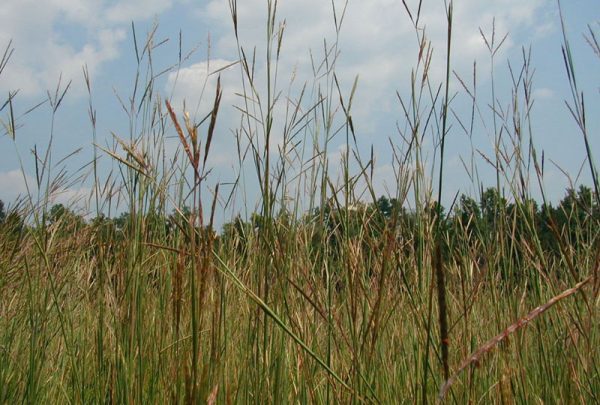Rediscovering the South’s forgotten grasslands

Once a myth takes hold in the fertile ground of the South, it often persists with a vengeance. Many people still believe early European settlers arrived to find an unbroken canopy of trees sheltering the Piedmont. According to Reed Noss, author of Forgotten Grasslands of the South, “The lack of awareness of native grasslands in the South represents a case of collective amnesia. A few human generations ago, grasslands were abundant across much of the South; today they are rare.”
So rare, in fact, the term “grassland” usually brings to mind images of the Great Plains. In the South we sometimes have trouble seeing our grasses for the trees. In an area of abundant rainfall like the Piedmont, our grasslands often resemble forests. This is especially true of a mature longleaf forest, where an open canopy allows enough sunlight to reach the forest floor and encourage a lush herbaceous layer of grasses and forbs.
Longleaf pine forests once covered a significant portion of the Uwharries. In 1897, when renowned forester Gifford Pinchot and W.W. Ashe published an assessment of the timber and forests in North Carolina, Montgomery County supported some of the best remaining longleaf in the state. It was nearly as abundant as shortleaf in our forests. By the 1930s, most of it was gone, as were the grasses that flourished in conjunction with those old-growth trees. That occurred roughly three generations ago, just as Noss asserts.
Preserved grasslands nearbyMecklenburg County owns six sites featuring conserved or re-created grasslands: McDowell Nature Preserve, Gar Creek Nature Preserve, Latta Plantation Nature Preserve, Winget Park, Shuffletown Nature Preserve and Flat Branch Nature Preserve. The Mecklenburg County Park & Recreation Department also monitors six privately owned grassland sites. Among the other preserved grasslands in the region are sites at Cane Creek Park in Union County, the Mineral Springs Barrens in Union County, and a site at Crowders Mountain State Park in Gaston County. |
Today, our pastures, fields and pine plantations – not to mention our culverts, malls and subdivisions – are a testament to the human presence in the Piedmont landscape. Because of our region’s propensity to sprout trees, our grasslands have also been seen as a man-made landscape, largely the result of American Indians setting fires to flush out game or improve the area for cultivation. That was the general conclusion of UNC Charlotte professor emeritus Larry Barden, a biologist and one of the first scientists to take an interest in Piedmont prairies, in a seminal paper in 1997. Those activities likely shaped the vast savannahs that explorer John Lawson encountered in 1701. He described one as being 25 miles wide. That said, endemic plants such as the Schweinitz’s sunflower and smooth coneflower would have evolved prior to the American Indian presence here, which began approximately 12,000 years ago. That suggests that human intervention merely enhanced and enlarged what was already present in the Piedmont landscape.
Noss points to several natural factors that can counter our abundant rainfall and produce grassy openings in our forests. In the Uwharries, we average four to eight lightning flashes per kilometer each year, enough to produce regular wildfires. Once set, they could spread with little impediment across our relatively gentle topography. Fires, whether accidental or intentional, would have been necessary to maintain the healthy stands of longleaf and shortleaf pines historically found in our forests. In fact, in an assessment of our forests in 1894, Ashe laments the “loss of future growth” due to the “systematic burning to which those lands are subjected.” At the time, misguided foresters believed fire was detrimental to longleaf forests.
Large herbivores such as bison and elk once roamed the Piedmont landscape. According to Noss, “pioneer naturalist Mark Catesby reported that ‘buffalo ranged in droves.’ ” Those animals would have been instrumental in maintaining grassland vegetation. Buffalo were reportedly extirpated from Randolph County in 1802, the last one shot by a Mr. Dollarhide on what is now the eastern flank of the Birkhead Wilderness Area.
The land itself can sometimes create situations inhospitable to trees. Steep slopes, rock barrens and diabase soils tend to favor grasses. Wind is less of an issue in the Piedmont, but at higher elevations it can help maintain the Appalachian’s scenic grassy balds. Water can also limit the growth of trees. In the Piedmont, this can be seen in the riverscour prairies that sometimes occur in our riparian areas.
In researching his book, Noss traveled across the South, observing those factors at work in the field. He came to the Uwharries to see the Schweinitz’s sunflower restoration efforts, and he went to Mount Pleasant to witness the remarkable Suther Prairie in Cabarrus County. The Suther family has farmed the surrounding land for more than 200 years, but to their knowledge, this unique 5-acre tract has never been grazed or tilled. They believe a sentimental German ancestor set it aside because it reminded him of meadows along the Rhine. In addition to being a rare example of unbroken ground, this site is wet while most remaining fragments of Piedmont prairie are dry. Wetland species like sedges, ladies’ tresses and atamasco lily appear among the clumps of big bluestem and other native grasses.
The Suther family has kept the memory of our Southern grasslands alive. Today, Reed Noss and a cadre of dedicated scientists, landowners and resource managers are helping reconnect us with this evocative aspect of our natural and cultural heritage.
Many thanks to local forester Boon Chesson for sharing his research on the history of longleaf in the Uwharries. Thanks also to Laura Fogo and John Suther for the photos (see more below).
More photos of N.C. grasslands
[view:slideshow2=block_1]